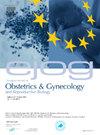TRANSFER: ThReatened preterm birth, assessment of the need for in-utero tranSFER between 22 + 0–23 + 6 weeks’ gestation, a multicentre prospective service evaluation across the United Kingdom
IF 2.1
4区 医学
Q2 OBSTETRICS & GYNECOLOGY
European journal of obstetrics, gynecology, and reproductive biology
Pub Date : 2025-03-11
DOI:10.1016/j.ejogrb.2025.03.030
引用次数: 0
Abstract
TRANSFER was established following updated guidance from British Association of Perinatal Medicine, suggesting offering survival focussed care from 22 + 0 weeks’ gestation. The number of women presenting with threatened preterm birth at this gestation is unknown; essential data to facilitate adequate service provision and planning for UK perinatal services.
Objectives
To identify women presenting with threatened preterm birth between 22 + 0–23 + 6 weeks’ gestation across the UK and determine the number presenting ou + tside an obstetric unit with a Level 3 NICU. Record the number of in-utero transfers of women presenting between 22 + 0––23 + 6 weeks’ gestation and determine the number of women who deliver prior to 24 weeks’ gestation in units without a Level 3 NICU.
Design
Multicentre prospective service evaluation.
Setting
90 UK maternity units.
Patients
Women presenting with threatened preterm birth between 22 + 0–23 + 6 weeks’ gestation between 17/5/21–30/6/22.
Main outcome measures
Number of women presenting in each geographical region, need for in utero transfer, length of antenatal hospital stay and use of biomarkers to predict preterm birth.
Results
Between 22 + 0–23 + 6 weeks’ gestation:
1. 511 women presented with threatened preterm birth to UK obstetric units.
2. 286 (56%) women presented to obstetric units without level 3 NICU.
3. 217 (76%) women required transfer.
4. 41 (8%) women delivered in a unit without a Level 3 NICU (10 (24%) opted for survival focussed care).
Conclusions
Women presenting with threatened preterm birth between 22 + 0–23 + 6 weeks gestation is higher than anticipated and is likely to be an under-representation of actual number of presentations.
求助全文
约1分钟内获得全文
求助全文
来源期刊
CiteScore
4.60
自引率
3.80%
发文量
898
审稿时长
8.3 weeks
期刊介绍:
The European Journal of Obstetrics & Gynecology and Reproductive Biology is the leading general clinical journal covering the continent. It publishes peer reviewed original research articles, as well as a wide range of news, book reviews, biographical, historical and educational articles and a lively correspondence section. Fields covered include obstetrics, prenatal diagnosis, maternal-fetal medicine, perinatology, general gynecology, gynecologic oncology, uro-gynecology, reproductive medicine, infertility, reproductive endocrinology, sexual medicine and reproductive ethics. The European Journal of Obstetrics & Gynecology and Reproductive Biology provides a forum for scientific and clinical professional communication in obstetrics and gynecology throughout Europe and the world.

 求助内容:
求助内容: 应助结果提醒方式:
应助结果提醒方式:


